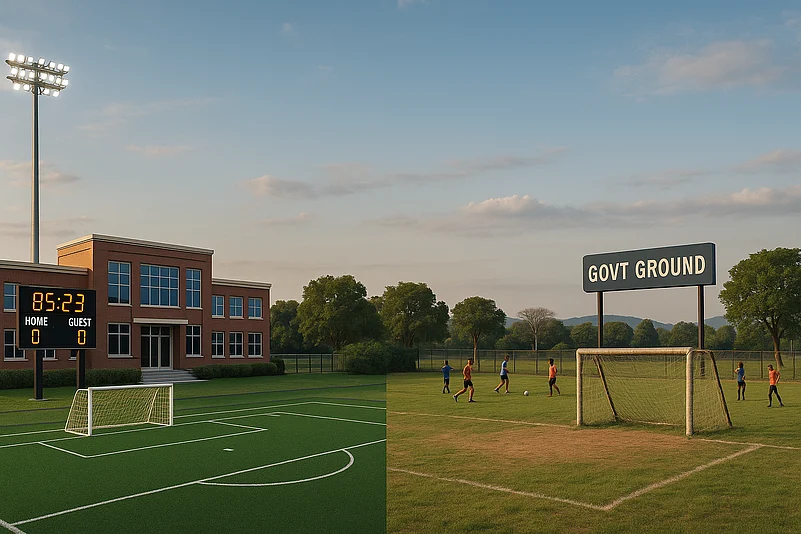India’s sports ecosystem is undergoing a rapid transformation, driven by both private and government initiatives. Yet, a persistent gap remains between the state-of-the-art facilities of private sports institutes and the often under-resourced government grounds. Technology, however, is emerging as a powerful equalizer, offering scalable solutions to bridge this divide, democratize access, and elevate Indian sports to global standards.
The Current Landscape: Private vs. Government Sports Facilities
Private Sports Institutes:
Private academies and institutes have proliferated across India, offering world-class infrastructure, specialized coaching, and access to the latest training technologies. These institutions, often backed by significant investments and corporate sponsorships, cater to elite athletes as well as aspiring youngsters. Facilities like synthetic turf, smart gyms, biomechanical analysis labs, and AI-driven performance tracking are becoming standard in such centers.
Government Grounds:
Government-run sports grounds, managed by bodies like the Sports Authority of India (SAI) and various state sports councils, form the backbone of grassroots sports. They provide widespread access but often struggle with outdated infrastructure, limited maintenance, and a lack of advanced training tools. Despite these challenges, government investment is substantial: over 90 National Investment Pipeline (NIP) projects for stadiums and sports complexes are underway, with sporting projects worth $1.49 billion approved and the private sector holding a 21% share in implementation.
Aspect |
Private Institutes |
Govt Grounds |
Infrastructure Quality |
High-tech modern well-maintained |
Varies often basic or outdated |
Access |
Selective often fee-based |
Broad community-focused affordable |
Coaching |
Specialized data-driven |
General may lack latest methodologies |
Technology Integration |
Advanced (AI VR analytics) |
Limited but improving |
Technology as the Great Equalizer
1. Smart Infrastructure and Maintenance
Modern technologies—such as artificial turf, LED lighting, and digital maintenance systems—are now being adopted in both private and public facilities. These innovations reduce long-term costs, improve playing conditions, and ensure consistent quality regardless of weather or usage. For example, synthetic and hybrid turfs require less maintenance and provide uniform surfaces, now being installed in government complexes and schools across India.
2. AI and Data Analytics for Training
AI-powered performance analysis tools, once exclusive to private academies, are increasingly accessible to government-run centers. These systems use wearable sensors, high-speed cameras, and machine learning algorithms to monitor athlete performance, prevent injuries, and fine-tune training programs. Indian IT giants like Infosys and Tech Mahindra have developed AI solutions that deliver real-time statistics and advanced video coaching, which are being piloted in national training centers.
3. Virtual and Augmented Reality (VR/AR) Training
Virtual reality and augmented reality are revolutionizing skill development. VR-based simulators and AR-assisted coaching enable athletes to practice techniques, analyze plays, and visualize strategies, even in resource-constrained settings. Such tools can be deployed in government facilities to provide immersive training experiences previously limited to private institutes.
4. Smart Stadiums and Fan Engagement
Smart stadium technologies—digital ticketing, IoT-enabled seating, advanced security, and AR displays—are making their way into government-run venues. The Wankhede Stadium, for example, integrates IoT-driven smart seating and contactless transactions, setting a benchmark for public facilities. These upgrades not only enhance athlete and fan experiences but also improve operational efficiency.
5. Public-Private Partnerships (PPPs) and Policy Support
Government schemes like Khelo India and Fit India Movement, coupled with private investment, are accelerating tech adoption in public sports infrastructure. PPP models allow for knowledge transfer, shared funding, and faster project execution, ensuring that even government grounds can benefit from the latest advancements.
How Technology Can Transform Indian Sports
Leveling the Playing Field
Access to Elite Training: AI-driven coaching and performance analysis can be scaled across thousands of government grounds, allowing young athletes from all backgrounds to receive world-class training without the need for expensive private academies.
Injury Prevention and Athlete Longevity: Wearable sensors and analytics help monitor athlete health, reducing injury rates and extending careers—a crucial factor for India’s medal prospects on the global stage.
Cost-Effective Facility Management: Smart maintenance systems and synthetic surfaces lower operational costs, freeing up resources for talent development and grassroots outreach.
Boosting Grassroots Development
Wider Talent Identification: Data analytics can help scout and nurture talent in rural and semi-urban areas, democratizing opportunities and expanding the national talent pool.
Multi-Sport Complexes: Modular and multi-purpose stadiums, powered by tech, can host various sports and community events, optimizing resource use and increasing participation.
Enhancing Fan Engagement and Revenue
Digital Platforms: Mobile apps, AR experiences, and cashless ticketing make sports events more accessible and engaging, driving higher attendance and sponsorship opportunities.
Sustainable and Green Initiatives: Eco-friendly technologies—solar panels, rainwater harvesting—are being integrated into new government projects, aligning with global sustainability goals and reducing long-term costs.
Factually Accurate Data & Recent Developments
Investment Surge: Over 90 NIP projects for sports infrastructure are in progress, with $1.49 billion allocated and a 21% private sector share.
State Initiatives: Haryana spent over $18 million on infrastructure for the Khelo India Youth Games 2022. Odisha invested $86.66 million in 89 multi-purpose indoor stadiums to host international tournaments.
Tech Integration: Indian IT firms showcased AI-driven sports solutions at the Paris Olympics, providing real-time analytics and immersive fan experiences.
Smart Stadiums: Facilities like Wankhede Stadium now feature IoT-enabled seating, AR displays, and contactless services, setting new standards for public venues.
The Road Ahead: Closing the Gap
Bridging the gap between private sports institutes and government grounds is not just about infrastructure, it’s about leveraging technology to create a level playing field. With proactive policy support, increased private investment, and widespread tech adoption, India is poised to nurture a new generation of athletes who can compete and win on the world stage.
By integrating advanced technologies into government grounds, India can ensure that talent, not privilege, determines sporting success. The future of Indian sports lies in a tech-enabled ecosystem where every athlete, regardless of background, has the tools to excel. This transformation is not just possible, it is already underway, promising a brighter, more inclusive future for Indian sports.















